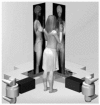Predicting growth and curve progression in the individual patient with adolescent idiopathic scoliosis: design of a prospective longitudinal cohort study
- PMID: 20478013
- PMCID: PMC2881883
- DOI: 10.1186/1471-2474-11-93
Predicting growth and curve progression in the individual patient with adolescent idiopathic scoliosis: design of a prospective longitudinal cohort study
Abstract
Background: Scoliosis is present in 3-5% of the children in the adolescent age group, with a higher incidence in females. Treatment of adolescent idiopathic scoliosis is mainly dependent on the progression of the scoliotic curve. There is a close relationship between curve progression and rapid (spinal) growth of the patient during puberty. However, until present time no conclusive method was found for predicting the timing and magnitude of the pubertal growth spurt in total body height, or the curve progression of the idiopathic scoliosis.The goal of this study is to determine the predictive value of several maturity indicators that reflect growth or remaining growth potential, in order to predict timing of the peak growth velocity of total body height in the individual patient with adolescent idiopathic scoliosis. Furthermore, different parameters are evaluated for their correlation with curve progression in the individual scoliosis patient.
Methods/design: This prospective, longitudinal cohort study will be incorporated in the usual care of patients with adolescent idiopathic scoliosis. All new patients between 8 and 17 years with adolescent idiopathic scoliosis (Cobb angle >10 degrees) visiting the outpatient clinic of the University Medical Center Groningen are included in this study. Follow up will take place every 6 months. The present study will use a new ultra-low dose X-ray system which can make total body X-rays. Several maturity indicators are evaluated like different body length dimensions, secondary sexual characteristics, skeletal age in hand and wrist, skeletal age in the elbow, the Risser sign, the status of the triradiate cartilage, and EMG ratios of the paraspinal muscle activity. Correlations of all dimensions will be calculated in relationship to the timing of the pubertal growth spurt, and to the progression of the scoliotic curve. An algorithm will be made for the optimal treatment strategy in the individual patient with adolescent idiopathic scoliosis.
Discussion: This study will determine the value of many maturity indicators and will be useful as well for other clinicians treating children with disorders of growth. Since not all clinicians have access to the presented new 3D X-ray system or have the time to make EMG's, for example, all indicators will be correlated to the timing of the peak growth velocity of total body height and curve progression in idiopathic scoliosis. Therefore each clinician can chose which indicators can be used best in their practice.
Trial registration number: NTR2048.
Figures





Similar articles
-
Does the Use of Sanders Staging and Distal Radius and Ulna Classification Avoid Mismatches in Growth Assessment with Risser Staging Alone?Clin Orthop Relat Res. 2021 Nov 1;479(11):2516-2530. doi: 10.1097/CORR.0000000000001817. Clin Orthop Relat Res. 2021. PMID: 34036944 Free PMC article.
-
Curve progression in idiopathic scoliosis: follow-up study to skeletal maturity.Spine (Phila Pa 1976). 2009 Apr 1;34(7):697-700. doi: 10.1097/BRS.0b013e31819c9431. Spine (Phila Pa 1976). 2009. PMID: 19333102
-
Integrated Multidimensional Maturity Assessments Predicting the High-risk Occurrence of Peak Angle Velocity During Puberty in Progressive Female Idiopathic Scoliosis.Clin Spine Surg. 2017 May;30(4):E491-E496. doi: 10.1097/BSD.0000000000000203. Clin Spine Surg. 2017. PMID: 28437358
-
Utilization of distal radius and ulna classification scheme in predicting growth peak and curve progression in idiopathic scoliosis girls undergoing bracing treatment.Eur Spine J. 2020 Apr;29(4):770-778. doi: 10.1007/s00586-020-06289-8. Epub 2020 Jan 16. Eur Spine J. 2020. PMID: 31950352 Review.
-
Adolescent idiopathic scoliosis: is rising growth rate the triggering factor in progression?Eur Spine J. 1993 Jun;2(1):29-36. doi: 10.1007/BF00301052. Eur Spine J. 1993. PMID: 20058445 Review.
Cited by
-
In-Brace versus Out-of-Brace Protocol for Radiographic Follow-Up of Patients with Idiopathic Scoliosis: A Retrospective Study.Children (Basel). 2022 Mar 25;9(4):465. doi: 10.3390/children9040465. Children (Basel). 2022. PMID: 35455509 Free PMC article.
-
The value of shoe size for prediction of the timing of the pubertal growth spurt.Scoliosis. 2011 Jan 20;6(1):1. doi: 10.1186/1748-7161-6-1. Scoliosis. 2011. PMID: 21251310 Free PMC article.
-
CORR Insights®: Curve Progression in Adolescent Idiopathic Scoliosis Does Not Match Skeletal Growth.Clin Orthop Relat Res. 2018 Feb;476(2):437-438. doi: 10.1007/s11999.0000000000000128. Clin Orthop Relat Res. 2018. PMID: 29389798 Free PMC article. No abstract available.
-
Generalized joint hypermobility, scoliosis, patellofemoral pain, and physical abilities in young dancers.BMC Musculoskelet Disord. 2021 Feb 9;22(1):161. doi: 10.1186/s12891-021-04023-z. BMC Musculoskelet Disord. 2021. PMID: 33563260 Free PMC article.
-
Adolescent idiopathic scoliosis: evidence for intrinsic factors driving aetiology and progression.Int Orthop. 2016 Oct;40(10):2075-2080. doi: 10.1007/s00264-016-3132-4. Epub 2016 Mar 10. Int Orthop. 2016. PMID: 26961194 Review.
References
-
- Cheung J, Veldhuizen AG, Halbertsma JP, Maurits NM, Sluiter WJ, Cool JC. The relation between electromyography and growth velocity of the spine in the evaluation of curve progression in idiopathic scoliosis. Spine (Phila Pa 1976) 2004;29:1011–1016. - PubMed
-
- Loncar-Dusek M, Pecina M, Prebeg Z. A longitudinal study of growth velocity and development of secondary gender characteristics versus onset of idiopathic scoliosis. Clin Orthop Relat Res. 1991. pp. 278–282. - PubMed
-
- Wever DJ, Tonseth KA, Veldhuizen AG. Curve progression and spinal growth in brace treated idiopathic scoliosis. Stud Health Technol Inform. 2002;91:387–392. - PubMed
Publication types
MeSH terms
LinkOut - more resources
Full Text Sources
Medical

